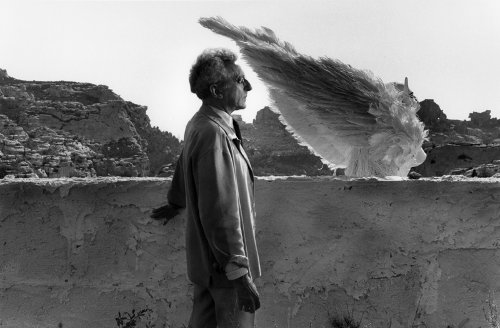As part of its policy to enhance its collections, the Musée Réattu continually encourages artists, collectors, public and private institutions to deposit works of art in Arles. This deposition practice enables the historical collections of the museum to be examined in terms of new artistic and historical issues by offering the public, but also the conservation, at the service of the public and museum documentation the opportunity to study the works over a longer period than classical loans, limited to barely a few months. This year the museum approached a collector who agreed to deposit 33 graphic and photographic works in the City of Arles. The museum thereby enriches the photography department, enabling artists like Grégoire Alexandre, Véronique Ellena, Daniel Firman, Laurent Goumarre, Eloïse van der Heyden, Guillaume Janot, Bettina Komenda, Delphine Kreuter, Annie Leibovitz, Christophe Mattern, Sarah Moon, Martin Parr, Anne and Patrick Poirier, Michaël Roy, Dana Salvo, Nils Udo, Javier Vlahonrat, to be part of the collection, opening new paths for exploration.
Born in Germany in 1959, Brigitte Bauer has lived and worked in Arles since 1987. She graduated from the École Nationale Supérieure de la Photographie d’Arles in 1990 and Aix-Marseille University in 1995. She has taught photography at the École Supérieure des beaux-arts de Nîmes since 2005.
Her photographs feature in many public and private collections.
Using Mont Sainte-Victoire as a subject, Brigitte Bauer inevitably came up against the legacy of Cézanne, whose varying versions of the subject marked a turning point in the history of art. This series however owes less to the master of Aix’s painting than to an essay by the Austrian author Handke. The Teachings of Sainte-Victoire, published by Gallimard in 1985, is presented in the form of an initiatory account triggered by seeing the painting of Sainte-Victoire in an exhibition devoted to Cézanne at the Grand Palais, that haunted the protagonist to the point of compelling him to walk to the mountain seeking the artist’s viewpoint.
This idea of peregrination is behind the principle for the series Paysages de la Sainte-Victoire, which are like many translations of Handke’s writing into image: the same way of circumventing the mountain, representing the bends and curves of the roads and paths, the shift and distance from the viewpoints. The mountain oscillates between the image’s central motif and backdrop, sometimes close and almost palpable, sometimes distant and hazy. Brigitte Bauer sees the means to renew the initial sense of wonder experienced in the face of this limestone monument–the role of returning to the motif, according to the time of day or the season –while finding a subject that allows her to develop a personal aesthetic of the landscape.
Roel Jacobs exhibited at the Rencontres de la Photographie d'Arles for the first time in 1979 within a group of Belgian photographers, including photographers who feature in the museum collections like Pierre Cordier and Hubert Grooteclaes. Acknowledgement of these two authors, specialists experimenting with photography, reminds us of the context in which the work of Roel Jacobs emerged: a period of questioning, that led photographers to move beyond the matter of subject– portrait, street scenes, landscape – benefitting a reflection on the very principles of photography. The personal exhibition devoted to him in 1982, called Observations dans le temps/ Checks on time (which helped him win the Young Photographer Award) reflects work produced in previous years in the region and research that extended throughout his career.
Among the areas that structure the Musée Réattu’s photography collection, the Rencontres d'Arles is fundamental. The museum is becoming increasingly established as the memory of the festival by committing to store the regular deposits that it provides, but above all by encouraging photographers, through its exhibitions, to enrich the photographic history of Arles with their testimonies.

Lucien Clergue was responsible, with the curator Jean-Maurice Rouquette, for the creation of the Musée Réattu’s ‘Photographic Art Department’ in 1965. A major player in the direction of Arles in photographic terms, he has also donated over two hundred photographs to the museum. The City of Arles and the museum wished to definitively clinch their attachment to one of the most prominent artists that Arles has produced through the acquisition of a set of ten photographs regarding the shooting of Jean Cocteau’s film Le Testament d'Orphée. This series, fundamental in the photographer’s work was only represented to date in the collections by a single image. The filming of LeTestament d'Orphée partly took place in the village of Les Baux-de-Provence and in the quarries of the Val d'Enfer between 7th and 22nd September 1959. Picasso suggested this powerful environment to Cocteau, making Lucien Clergue responsible for scouting the spots most suitable for filming and to ensure the photo coverage. The photographer produced over two thousand shots enabling the progression of the script to be followed, workdays, behind the scenes or between shots captured. It is one of few series representative of the documentary vein of the Arlesian photographer, who nonetheless found a way of extending beyond his subject in this restricted exercise. The ten images chosen among the huge number of shots taken at the time capture the balance found by Clergue between photography purely associated with the filming – on which the actors can be clearly distinguished and understanding the context of the film – and freer photography, in which he expresses his meaning of the narrative and composition.